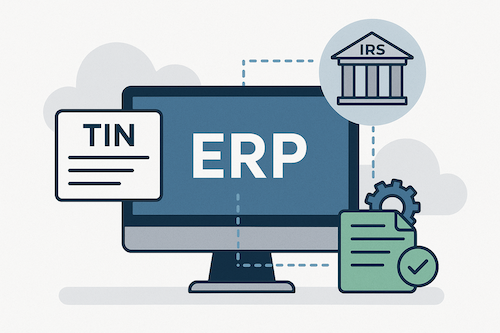
Table of Contents
In the intricate web of enterprise resource planning (ERP) systems, the accuracy of vendor and payee data stands as a cornerstone of financial integrity. Yet, ensuring this accuracy, particularly for Taxpayer Identification Numbers (TINs), presents an ongoing challenge. A misstep here doesn’t just ripple; it can escalate into significant compliance headaches and financial penalties. It’s a common scenario observed across numerous system landscapes: organizations grapple with this, often reactively. How then can organizations fortify their defenses? Integrating robust TIN matching processes directly within the ERP environment is a strategic imperative, not merely a procedural task. This isn’t just about ticking a box; it’s about embedding resilience into your financial operations.
The Criticality of Accurate TINs in Enterprise Ecosystems
The landscape of financial compliance is exacting. For U.S. businesses, the Internal Revenue Service (IRS) mandates accurate TINs for all payees to whom reportable payments are made, primarily documented on various Form 1099s. Failure to furnish a correct TIN can lead to backup withholding requirements, where a payer must withhold tax from payments. More directly, incorrect TINs on information returns can trigger penalties from the IRS. Insights distilled from numerous complex system deployments indicate that manual data entry, disparate data sources, and infrequent validation cycles are common culprits behind TIN discrepancies residing within ERP systems. These aren’t isolated incidents; they often represent systemic gaps in data governance that can prove costly. These discrepancies often surface at the most inopportune times, particularly during year-end closing and tax preparation, creating significant operational strain.
The IRS TIN Matching Program: A Foundational Tool
Recognizing the need for proactive validation, the IRS offers a TIN Matching Program. This program permits payers, before filing information returns, to check whether a payee-provided name and TIN combination matches the IRS’s records. The IRS maintains a dedicated database for this purpose and informs the participant of the match status. This service, accessible via e-Services, offers both interactive (up to 25 TINs at a time) and bulk (up to 100,000 TINs via file upload) options, returning a numerical code to indicate the outcome (e.g., ‘0’ for a match, ‘1’ for missing/incorrect TIN format, ‘2’ for a non-issued TIN, ‘3’ for a mismatch). While a valuable resource, relying solely on manual or ad-hoc use of this program often falls short in a dynamic enterprise setting. The real leverage comes from its systematic application. Utilizing this program is a key step in reducing errors and minimizing the risk of subsequent penalties and backup withholding notices.
Leveraging ERP Systems for Proactive TIN Verification
While the IRS provides the tool, the ERP system offers the ideal platform to operationalize TIN matching efficiently. A perspective forged through years of navigating real-world enterprise integrations suggests that embedding TIN verification within standard ERP workflows is paramount. Consider the vendor onboarding process: an ERP can be configured to trigger a TIN validation check. This is often done through batch file processing for bulk IRS checks or via an integrated third-party compliance solution that may offer real-time capabilities. This check should occur before a new vendor record is fully activated or eligible for payment. Imagine the efficiency gained when this check is a non-negotiable step within the digital workflow, preventing problematic data from taking root. Similarly, checks can be initiated prior to payment runs, acting as a final safeguard.
This proactive approach, embedded within the ERP, offers several advantages:
- Reduced Manual Intervention: Automating the check at data entry or before payment runs significantly cuts down on manual effort and the potential for human error. This frees up valuable finance team resources for more strategic activities.
- Timely Error Resolution: Identifying mismatches early allows for prompt outreach to payees for correction, long before critical tax filing deadlines. It transforms a reactive scramble into a proactive management task.
- Enhanced Data Integrity: Systematically validating TINs improves the overall quality of master data within the ERP, benefiting various downstream processes. Reliable data is the bedrock of effective financial reporting and analytics.
Beyond Compliance: The Broader Strategic Gains
Integrating TIN matching into the ERP framework transcends basic regulatory adherence. It bolsters financial controls by ensuring payments are directed to correctly identified payees, thereby reducing the risk of payment fraud. This isn’t merely theoretical; strengthened controls are a tangible outcome observed when such integrations are thoughtfully implemented. Operationally, it streamlines the accounts payable process and alleviates the year-end scramble for TIN corrections. This contributes to smoother supplier relationships, as accurate data minimizes payment delays or anachronistic withholding. Think of the improved trust and efficiency in your procure-to-pay cycle.
From a seasoned, practical viewpoint, organizations that embed such verification deep within their enterprise systems demonstrate a mature approach to financial data governance. It’s an acknowledgment that data quality is not an ancillary task but a core component of operational excellence and risk mitigation. With global regulatory scrutiny intensifying, proactive measures like integrated TIN matching are no longer just best practice; they are fundamental to resilient enterprise operations. The conversation shouldn’t be if but how effectively this is woven into the fabric of your ERP strategy.
These analyses stem from direct experience navigating the evolving landscape of enterprise technology. If these insights resonate or you’re keen to discuss further patterns in system strategy, I welcome you to connect with me on LinkedIn.